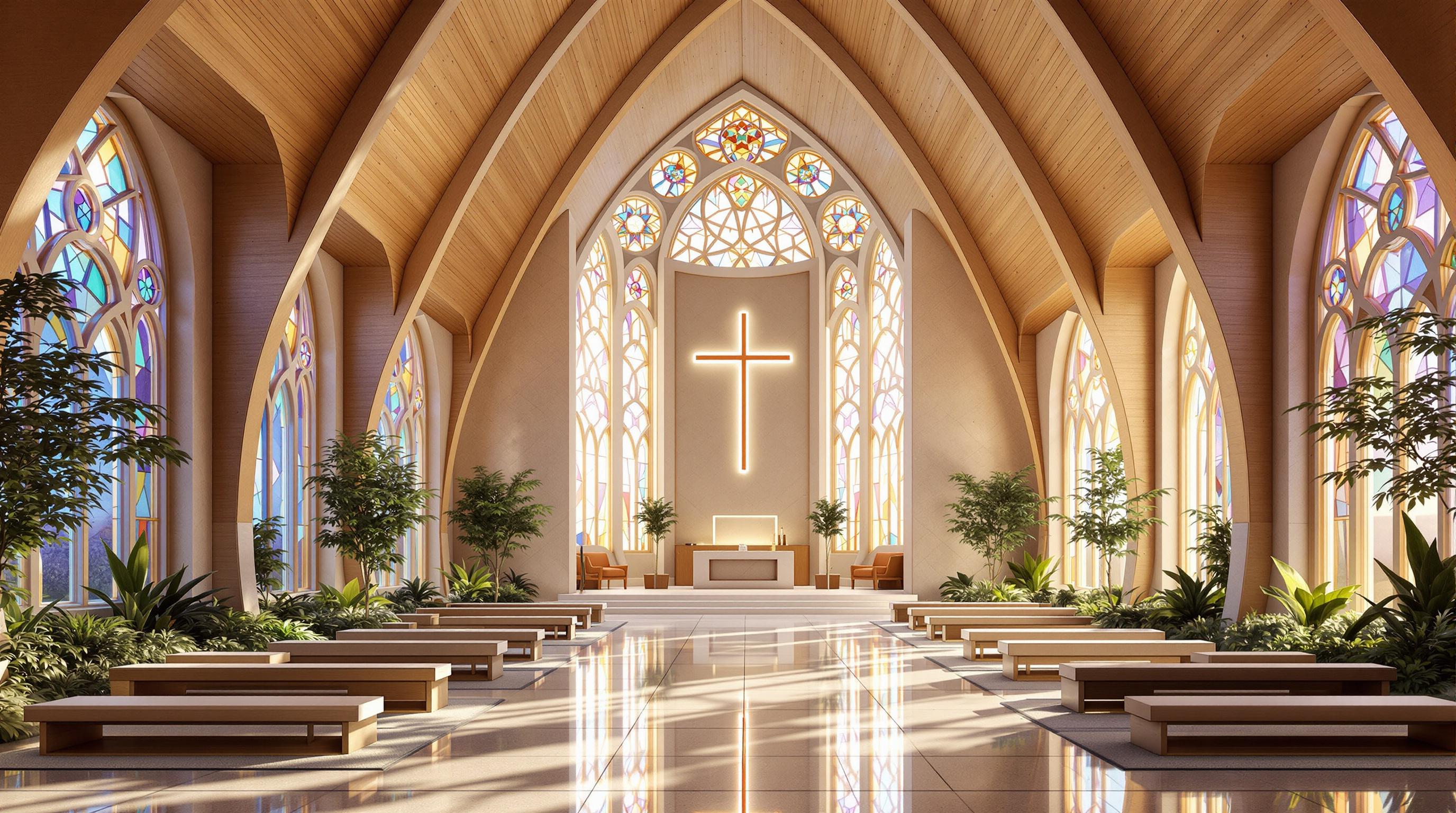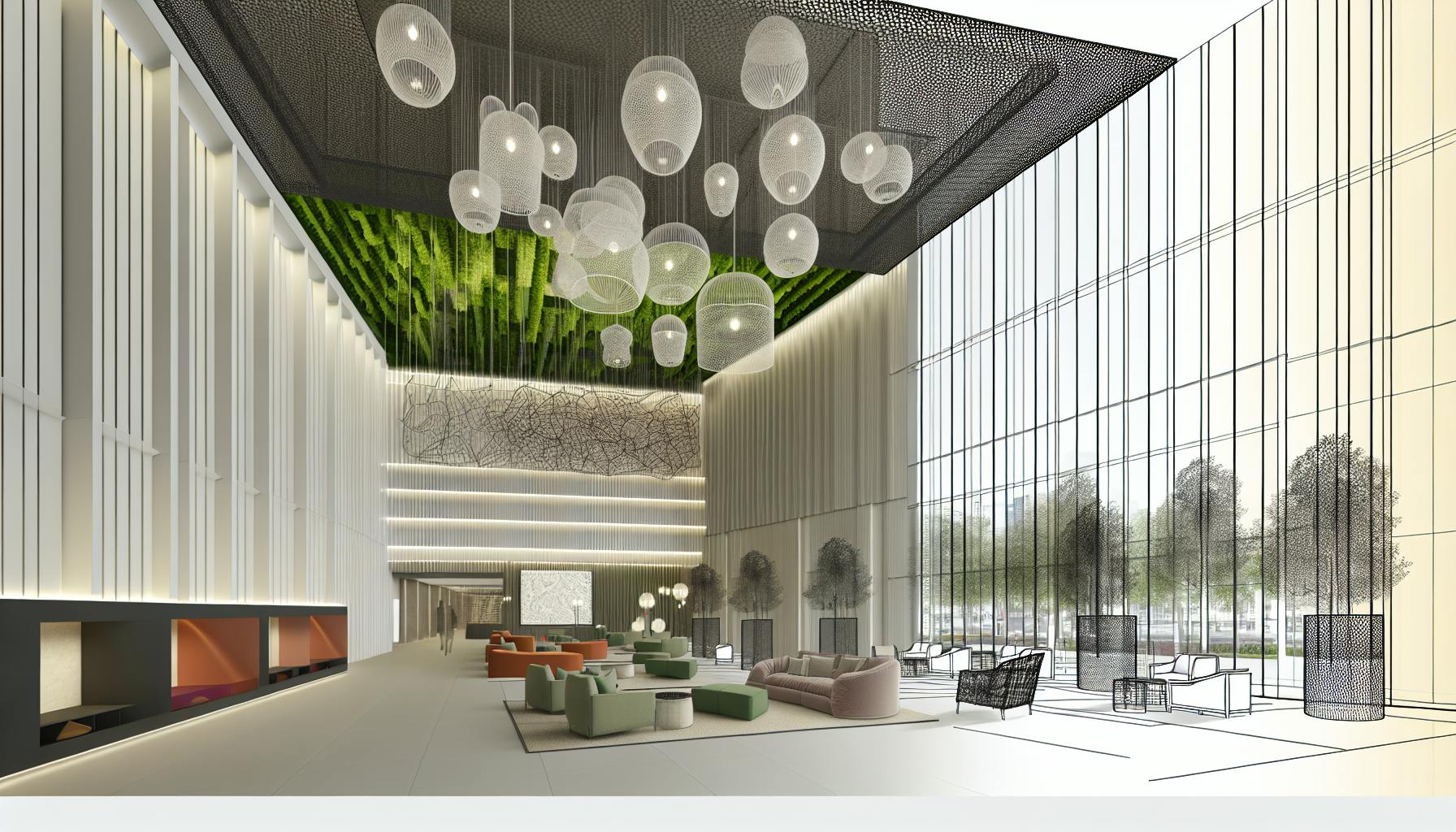The Golden Ratio, approximately 1.618, is a mathematical proportion known for creating balance and harmony. During the Renaissance, architects like Alberti and Palladio used this ratio to design iconic buildings, blending mathematical precision with aesthetic appeal. From facades to interior layouts, the Golden Ratio shaped Renaissance architecture and influenced later styles, including Baroque and Modernism.
Key points:
- The Golden Ratio was central to Renaissance design for achieving visual harmony.
- Architects like Alberti and Palladio incorporated it into structures like the Basilica of Santa Maria Novella and Villa Rotonda.
- Techniques included modular design, geometric overlays, and proportional grids.
- Tools like Architecture Helper now make it easier to analyze these proportions in historical and modern buildings.
The Renaissance's use of the Golden Ratio shows how mathematical principles can guide timeless architectural design, offering lessons that still resonate in today's architecture.
Renaissance Discoveries: Proportion
Golden Ratio in Renaissance Architectural Theory
During the Renaissance, architects wove the Golden Ratio into their design philosophies, turning ancient mathematical ideas into actionable principles for creating harmony and balance in their structures. These theoretical advancements shaped architectural practices for generations.
Key Renaissance Thinkers and Their Contributions
Leon Battista Alberti, in De Re Aedificatoria (1485), championed the idea that mathematical proportions were essential to visual harmony. His work on the facade of Santa Maria Novella is a striking example of this philosophy in action.
Andrea Palladio expanded on these ideas in his Four Books of Architecture (1570). He stressed the importance of proportional relationships in design, which can be seen in the symmetry and balance of Villa Rotonda.
Sebastiano Serlio further advanced the use of proportions through his treatises, offering clear geometric guidelines. His work helped standardize proportional systems across Europe, setting the stage for systematic architectural design during the Renaissance.
Design Principles in Renaissance Architecture
Renaissance architects, inspired by these theories, developed meticulous design systems that used mathematical relationships, including the Golden Ratio, to achieve unity and order.
A key method involved modular design, where a single unit of measurement dictated the dimensions of windows, rooms, and other architectural elements. This approach ensured proportional consistency throughout the structure.
Facades also benefited from these principles. Using tools like the compass and straightedge, architects divided building facades into balanced sections, translating abstract mathematical concepts into tangible, harmonious designs. This blend of theory and practice resulted in timeless architectural achievements.
Examples of the Golden Ratio in Renaissance Buildings
The principles of the Golden Ratio come to life in the elegant facades of Renaissance architecture, showcasing a balance that feels both intentional and effortless. A prime example is the Basilica of Santa Maria Novella in Florence, where this mathematical concept was key to blending classical and medieval design elements into a cohesive whole.
Basilica of Santa Maria Novella
In 1470, Leon Battista Alberti transformed the Gothic facade of the Basilica by introducing Renaissance design principles, with the Golden Ratio at the heart of his approach. The facade’s proportions reflect this ratio through its carefully spaced columns, symmetrical arches, and the precise positioning of the central main door. Alberti further emphasized classical harmony by incorporating a Greek temple front motif, underscoring the structured elegance of his design.
sbb-itb-1be9014
How to Identify the Golden Ratio in Architecture
Spotting the Golden Ratio in Renaissance architecture requires careful observation and precise measurement. This mathematical ratio, approximately 1.618:1, can be found in various design elements, from the overall layout of facades to intricate decorative details. Modern tools make this process even more accessible.
Methods for Analyzing Proportions
One way to uncover the Golden Ratio is through geometric overlays. Start by taking a straight-on photograph of a building's facade. Then, draw a rectangle around key architectural features and divide the longer side by the shorter side. If the result is close to 1.618, you've likely found a Golden Ratio proportion.
Another approach is measurement comparison, which works particularly well with Renaissance structures. Focus on relationships like the height of columns compared to their spacing or the width of arches relative to their height. These measurements often reflect the Golden Ratio, as Renaissance architects, inspired by Vitruvius and Alberti, intentionally incorporated these proportions into their designs.
For more complex facades, proportional grid analysis can reveal hidden mathematical relationships. By placing a Golden Ratio grid over photos or architectural drawings, you can identify how key features align with this proportional system. Renaissance buildings frequently display a striking consistency in how their elements adhere to these principles.
The spiral method is useful for curved architectural elements. By drawing arcs within Golden Rectangles, you can trace spirals that align with decorative elements like scrollwork or pediments, further demonstrating the presence of the Golden Ratio.
Using Tools Like Architecture Helper

Digital tools like Architecture Helper simplify the process of analyzing proportions in Renaissance buildings. This platform allows you to upload photographs for detailed analysis, highlighting mathematical patterns and potential Golden Ratio relationships with visual overlays and numerical data.
Architecture Helper also features a library of analyzed buildings, showcasing how the Golden Ratio appears in iconic Renaissance structures. With detailed breakdowns, you can explore how architects like Alberti and Palladio used these principles to achieve harmony in their designs.
The platform's mix-and-match feature lets users experiment by combining Golden Ratio elements from different buildings. This hands-on approach helps you see how these proportions contribute to visual balance across various architectural styles.
Additionally, Architecture Helper's pattern recognition tools make it easy to compare multiple analyzed buildings side by side. From early 15th-century Florentine palaces to late Renaissance church facades, you'll see how the Golden Ratio consistently influenced architectural design across different periods and architects.
The Golden Ratio's Impact on Later Architecture
The Renaissance revival of the Golden Ratio left a lasting mark on architecture, influencing styles and movements for centuries. From the grandeur of Baroque churches to the sleek lines of modern skyscrapers, the proportional principles celebrated by Renaissance figures like Alberti and Palladio have become a cornerstone of Western architectural design.
Influence on Architectural Movements
During the Baroque period (1600–1750), architects embraced the Golden Ratio while experimenting with bold, dynamic designs. A standout example is Francesco Borromini's San Carlo alle Quattro Fontane in Rome, completed in 1641. Borromini's innovative use of curves and spatial flow was grounded in a mathematical sense of order, showcasing how Baroque architects merged dramatic artistry with precise proportions.
In Neoclassical architecture (1750–1850), there was a deliberate return to Renaissance ideals of harmony and balance. Thomas Jefferson’s Virginia State Capitol, finished in 1788, reflects his admiration for Palladio’s work. The building’s proportions and layout were carefully crafted, highlighting the enduring influence of Renaissance theories on symmetry and proportion.
The Beaux-Arts movement, which spanned the 19th and early 20th centuries, institutionalized these ideas further. At the École des Beaux-Arts in Paris, Renaissance-inspired proportion became a central focus of architectural education. This training shaped architects like Richard Morris Hunt, whose designs, including the opulent Breakers mansion (completed in 1895), applied these principles to create refined, balanced structures. These developments laid the groundwork for Modernist reinterpretations of proportional design.
Even in Modernist architecture, which largely abandoned historical ornamentation, the spirit of Renaissance proportionality remained alive. Le Corbusier’s Modulor system, for instance, incorporated human scale and mathematical harmony into modern design. His Unite d'Habitation in Marseille, completed in 1952, demonstrates how modern materials and construction techniques can still reflect the balanced proportions seen in earlier architectural eras.
Renaissance vs. Modern Approaches to Proportion
While the Golden Ratio itself has remained a constant concept, its use has shifted significantly over time. Renaissance architects often saw these proportions as a reflection of universal harmony, while modern architects tend to approach them as practical tools for achieving aesthetic balance. The table below highlights some key differences:
| Aspect | Renaissance Approach | Modern Approach |
|---|---|---|
| Philosophical Foundation | Seen as a symbol of cosmic order | Used to create visual balance and comfort |
| Application Method | Geometric constructions and manual calculations | Digital tools and computer-aided design |
| Focus | Facades and interior compositions | Spatial experience and functional design |
| Measurement Units | Human-scale local units | Standardized metric or imperial systems |
| Design Process | Proportions defined early, with details added later | Function prioritized first, proportions adjusted after |
| Documentation | Hand-drawn plans with geometric overlays | Digital models with precise mathematical analysis |
Modern architecture has also embraced new technologies and ideas, blending traditional proportional systems with cutting-edge tools. Digital design, for instance, has opened up exciting possibilities for exploring proportions in innovative ways. The Heydar Aliyev Center in Baku, completed in 2012, is a striking example. Its fluid, algorithm-driven curves reinterpret the quest for harmony, pushing the boundaries of what proportion can mean in contemporary architecture.
This evolution shows how Renaissance architects didn’t just create timeless buildings - they developed a design language of balance and proportion that continues to inspire. By adapting these principles to modern tools and priorities, today’s architects extend this legacy into the future.
Conclusion: Timeless Harmony Through the Golden Ratio
The story of the Golden Ratio in Renaissance architecture highlights how precise proportions can create a sense of natural beauty. What began as a mathematical concept from ancient Greece was reimagined by Renaissance masters like Alberti and Palladio, who turned numbers into breathtaking works of art and design.
Take, for instance, the Basilica of Santa Maria Novella. Its design showcases the Golden Ratio's ability to create a perfect balance, a quality that continues to captivate visitors centuries later. Structures like this remind us that mathematical harmony isn’t bound by time or place - it speaks a universal language. By blending rational precision with emotional resonance, the Golden Ratio offers architects a dependable guide to crafting spaces that feel effortlessly "right."
Today, modern tools like Architecture Helper allow us to uncover these proportional relationships with incredible accuracy. This accessibility empowers anyone, not just architects, to appreciate and understand why certain designs feel so harmonious. It’s a reminder that beauty, often thought to be subjective, can have a tangible, measurable foundation.
Even as architecture evolves with new materials and technologies, the lessons of the Renaissance remain relevant. The Golden Ratio continues to inspire, offering a framework for creating designs that are both innovative and enduring. Whether it’s a cozy home or a towering skyscraper, architects who grasp these principles can create spaces that resonate deeply with those who experience them.
The Renaissance masters didn’t stumble upon beauty by accident - they meticulously calculated and crafted their designs with purpose. This dedication to precision and creativity challenges today’s architects to approach their work with the same thoughtful intent. It’s a powerful reminder that great design isn’t just about innovation; it’s about understanding timeless principles and weaving them into modern contexts.
The Golden Ratio serves as a bridge between eras, connecting Renaissance palazzos to contemporary buildings through its enduring principles of balance and proportion. In a world that’s constantly changing, these mathematical relationships offer a sense of stability and connection to something deeper in human nature. The Golden Ratio’s legacy proves that while styles may shift, the pursuit of harmony in design remains as relevant as ever.
FAQs
How did Renaissance architects like Alberti and Palladio use the Golden Ratio in their designs?
Renaissance architects like Alberti and Palladio embraced the Golden Ratio to craft designs that exuded balance and harmony. Alberti, in particular, emphasized the role of proportion and symmetry in his architectural writings and brought these ideas to life in creations like the Palazzo Rucellai and the facade of Santa Maria Novella. By incorporating the Golden Ratio, these works achieved a sense of visual coherence that resonated with viewers.
Palladio also relied on mathematical principles, including the Golden Ratio, to shape his renowned villas and churches, such as Villa Rotonda and Villa Emo. He often used geometric forms like circles, squares, and rectangles to establish proportions that elevated the visual appeal of his structures. This meticulous attention to mathematical detail was key to the enduring elegance and charm of Renaissance architecture.
How can modern tools help identify the Golden Ratio in Renaissance architecture?
Modern technology has made spotting the Golden Ratio in Renaissance architecture much simpler by streamlining the analysis of proportions and layouts. Tools like specialized design software can overlay grids or templates to pinpoint Golden Ratio divisions, while graphic design programs such as Photoshop or Illustrator let users measure and tweak proportions with incredible precision.
These advancements are a game-changer for architects, historians, and enthusiasts. Whether studying historical masterpieces or integrating the Golden Ratio into modern designs, these tools take the guesswork out of the process. What once required painstaking manual calculations can now be done quickly and accurately, making it easier to explore the harmony and balance in architectural works.
How has the use of the Golden Ratio changed from Renaissance to modern architecture?
During the Renaissance, architects intentionally incorporated the Golden Ratio into their designs to achieve a sense of harmony and balance that felt almost divine. This principle was famously applied in masterpieces like St. Peter's Basilica, where its mathematical precision was celebrated for mirroring the beauty found in nature.
Today, the Golden Ratio still influences modern architecture, but its use has become more adaptable. Architects now blend it with other design principles to create visually appealing and balanced structures. This shift highlights a move away from strict mathematical rules toward using the ratio as a flexible guide for enhancing the aesthetics of contemporary designs.


